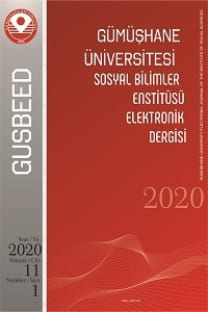Akıcılık ve Aşinalığın Yanlış Atfedilmesinin Otobiyografik Bellek Yargılarına Etkileri
Otobiyografik bellek, Tekrarın ön hazırlama etkisi, Akıcılık, Aşinalığın yanlış atfedilmesi, Yaşam Olayları Envanteri
Influences of Fluency and Familiarity Misattribution on Autobiographical Memory Judgments
Autobiographical memory, Repetition priming, Fluency, Familiarity misattribution, Life Event Inventory,
___
Bernstein, D. M., Godfrey, R. D., Davison, A. & Loftus E. (2004). Conditions affecting the revelation effect for autobiographical memory. Memory and Cognition, 32, 455-462.Bernstein, D. M., Whittlesea, B. W. & Loftus, E. F. (2002). Increasing Confidence in remote autobiographical memory and general knowledge: Extensions of revelation effect. Memory and Cognition, 30, 432-438.
Bernstein D.A, Rudd M.E, Erdfelder E, Godfrey, R, Loftus E.F (2009). The revelation effect for autobiographical memory: A mixture-model analysis. Psychonomic Bulletin and Review, 16, 463-468.
Brown, A.S., & Marsh, E.J. (2008). Evoking false beliefs about autobiographical experience. Psychonomic Bulletin & Review, 15, 186–190.
Brown, A.S., & Marsh, E.J. (2009). Creating Illusions of Past Encounter Through Brief Exposure. Psychological Science, 20(5), 534-538.
Conway, M. A. (2005). Memory and the self. Journal of Memory and Language,53(4), 594–628.
Conway, M. A., & Pleydell-Pearce, C.W. (2000). The construction of autobiographical memories in the self-memory system. Psychological Review, 107(2), 261–288.
Garry, M., Manning, C. G., Loftus, E. F., & Sherman, S. J. (1996). Imagination inflation: Imagining a childhood event inflates confidence that it occurred. Psychonomic Bulletin & Review, 3, 208–214.
Heaps, C., Nash, M. (1999). Individual differences in imagination inflation. Psychonomic Bulletin & Review, 6, 313–318.
Jacoby L. L, Dallas M. (1981). On the relationship between autobiographical memory and perceptual-learning. Journal of Experimental Psychology-General, 110(3), 306-340.
Jacoby L. L., Whitehouse K (1989). An illusion of memory - False recognition influenced by unconscious perception. Journal of Experimental Psychology-General, 118(2), 126-135.
Jacoby, L. L., Kelley, C. M., & Dywan, J. (1989). Memory attributions. In H. L. Roediger III & F. I. M. Craik (Eds.), Varieties of memory and consciousness: Essays in honour of Endel Tulving (pp. 391-422). Hillsdale, NJ: Erlbaum.
Jacoby, L.L., 1991. A process dissociation framework: Separating automatic from intentional uses of memory. Journal of Memory and Language, 30, 513-541.
Kelley C.M., Rhodes M.G., (2002). Making sense and nonsense of experience: attributions in memory and judgment. Psychology of learning and motivation: advances in research and theory, 41, 293-320.
Lindsay, D. S., Hagen, L., Read, J. D., Wade, K. A., & Garry, M. (2004). True photographs and false memories. Psychological Science, 15, 149-154.
Loftus, E. F., & Pickrell, J. E. (1995). The formation of false memories. Psychiatric Annals, 25, 720-725.
Loftus, E.F. (2003). Make-believe memories. American Psychologist, 58, 864–873.
Mendelsohn A., Furman O., Navon I., Dudai, Y. (2009). Subjective vs. documented reality: A case study of long-term real-life autobiographical memory. Learning and Memory, 16(2),142-146.
Oppenheimer D.M. (2008). The secret life of fluency. Trends in Cognitive Sciences, 12 (6), 237-241.
Rajaram, S. (1993). Remembering and knowing: Two means of access to the personal past. Memory & Cognition, 21, 89-102.
Scoboria, A., Mazzoni, G., Kirsch, I., & Relyea, M. (2004). Plausibility and belief in autobiographical memory. Applied Cognitive Psychology, 18, 791-807.
Scoboria, A., Mazzoni, G., Kirsch, I., & Jimenez, S. (2006). The effects of prevalence and script information on plausibility, belief, and memory of autobiographical events. Applied Cognitive Psychology, 20, 1049-1064.
Sharman, S.J., Garry, M. & Beuke, C. J. (2004). Imagination or exposure causes imagination inflation. American Journal of Psychology, 117(2), 157-168.
Sharman S.J., Barnier A.J. (2008). Imagining nice and nasty events in childhood or adulthood: Recent positive events show the most imagination inflation. Acta Psychologica, 129(2), 228-233.
Smeets, T., Merkelbach, H., Horselenberg, R., & Jelicic, M. (2005). Trying to recollect past events: Confidence, beliefs and memories. Clinical Psychology Review, 25(7), 917–934.
Whittlesea B. W. A., Jacoby L. L., Girard K. (1990). Illusions of immediate memory - evidence of an attributional basis for feelings of familiarity and perceptual quality. Journal of Memory and Language, 29(6), 716-732.
Whittlesea B. W. A., Leboe J. P. (2000). The heuristic basis of remembering and classification: Fluency, generation, and resemblance. Journal of Experimental Psychology-General, 129(1), 84-106.
Whittlesea B. W. A. (1993). Illusions of familiarity. Journal of Experimental Psychology-Learning Memory and Cognition, 19(6), 1235-1253.
Yonelinas A. P. (2002). The nature of recollection and familiarity: A review of 30 years of research. Journal of Memory and Language, 46(23), 441-517.
- ISSN: 1309-7423
- Yayın Aralığı: Yılda 3 Sayı
- Yayıncı: Gümüşhane Üniversitesi
Münevver ÇETİN, Mürüvvet KARTAL BAŞ
Gastronomi Turizmi Kapsamında Lezzetin İzinde Kokulu Üzüm
Makine Yenileme Kararlarında Geçerli Maliyet Analizi ile COPRAS Yönteminin Karşılaştırılması
Ailelerin Şehir İçi Rekreasyonel Algı ve Eğilimlerinin Belirlenmesi: İlkadım (Samsun) Örneği
Makyavelizmin Öğretim Üyelerinin Karar Verme Stilleri Üzerindeki Etkisi: Nicel Bir Araştırma
Türk Toplumunda Suriyeli Sığınmacı Algısı
Dursun YILMAZ, Mehmet Akif GÜNAY
